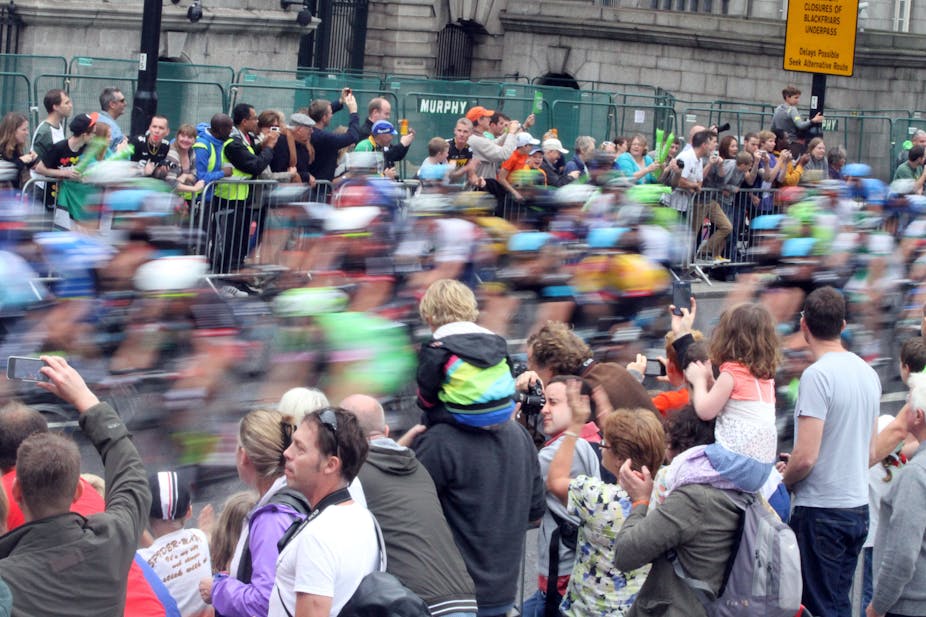When the world’s greatest cycling race starts in Yorkshire, England on July 5, some 2-3m visitors are expected to turn out to watch a spectacle which will cost an estimated £10m to host. If the organisers want to make their investment pay, their focus must be far beyond the “Grand Depart” and the carnival long weekend of lycra and lung-bursting sprints.
This will be the fourth time that the Tour de France has visited Britain. Plymouth hosted one stage in 1974; there were two from Dover to Brighton and around Portsmouth in 1994; and London and Canterbury hosted the start in 2007. This year the UK will host three stages: Stages 1 and 2 in Yorkshire, and Stage 3 from Cambridge to London.
Yorkshire’s bid to host the first two stages of Le Tour is estimated to cost in the region of £6.5m – a £4m “staging fee” to the race organisers ASO (Amaury Sport Organisation), and an additional £2.5m by local authorities to cover day-to-day hosting costs.
But there are other costs we need to consider. In 2007, the Grand Depart had a similar number of spectators line the route from London and Kent. A study by our team of researchers found that as well as having economic benefits, the event also had significant negative environmental impacts.
That environmental impact of the event was estimated by calculating its “ecological footprint”. This is the area of land required to support the resource demands and consumption patterns of spectators, and is measured in terms of global hectares. The total footprint was estimated to be 57,900 global hectares – equivalent to 143 times the area of London’s Olympic Park. And the ecological footprint of the average spectator at the Grand Depart was found to be almost 2.2 times greater than if they had not attended the event and gone about their everyday activities at home.
The main contributor to this was travel. The average spectator travelled 734 kilometres (456 miles) to watch the event. Almost 59% of the total distance travelled was by air (largely international air travel), which added significantly to the overall footprint. Other key contributors were rail (25%), coach (11%) and car (11%) travel.
Impact v legacy
In return for hosting Le Tour, Yorkshire is hoping for a significant financial return on its investment – a boost in excess of £100m for its local economy while promoting further tourism in the region, attracting inward investment, and increasing participation in cycling.
This raises several important questions, not least of which is whether the economic benefits to be gained from hosting a major sport event such as Le Tour outweigh any negative environmental impacts that it might generate. It is perhaps an issue that highlights how priorities change when an economy looks more fragile and non-financial factors get pushed to the periphery.
And while economic benefits are often used by organisers to galvanise support in the bidding for a sporting event, perhaps potential hosts should be required to estimate the environmental impacts too, in order that we might better understand the overall picture. Then the public might be more motivated to make sure officials are accountable for implementing effective strategies to reduce any negative impacts.
That last point is certainly more challenging as the characteristics of a host location will vary, and influence the scale and type of impacts in different ways. But it is certainly not clear what Yorkshire or the Tour organisers are doing to reduce the negative environmental impacts that will arise from Le Tour this year, in particular spectator travel.
Uphill task
On the positive side Cycle Yorkshire and its partners should be applauded for producing a strategy designed to promote cycling as a healthy and enjoyable physical activity, and a low polluting mode of transport. In order to offset those environmental costs, it will be crucial to generate positive legacies from hosting the 2014 Grand Depart and the hope is that Le Tour will inspire local residents to get on their bikes and maximise the many benefits of cycling. But, does the strategy go far enough?
Perhaps there is a valid trade-off between hosting the Le Tour and having 2-3m spectators create a large ecological footprint, and creating a positive environmental legacy – getting more locals on their bikes, improving their health and reducing motorised travel in Yorkshire in the long term.
But to embed those benefits and encourage a significant number of individuals to change the way in which they travel to work, shop or school will be an uphill challenge. Cycle Yorkshire itself acknowledges that there are “wide discrepancies in cycling infrastructure, participation and opportunities across the region”.
As with the rest of the country, the car is often the preferred choice of travel, and to have any real hope of achieving a more permanent behaviour change will require a continuous programme of investment in cycling infrastructure and networks in the region over many years – and not just the feelgood effects of a one-off event.

